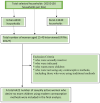Prevalence and factors associated with the use of long-acting reversible and permanent contraceptive methods among women who desire no more children in Bangladesh
- PMID: 40301957
- PMCID: PMC12039218
- DOI: 10.1186/s40834-024-00331-6
Prevalence and factors associated with the use of long-acting reversible and permanent contraceptive methods among women who desire no more children in Bangladesh
Abstract
Background: Long-acting reversible and permanent contraceptive methods (LARC/PM) with high efficacy and continuity of use are highly effective pregnancy prevention methods. However, most sexually active women do not use it and end up with unintended pregnancies and unsafe abortions in Bangladesh. This study aims to assess the prevalence of LARC/PM use and its determinants among sexually active women who desire no more children in Bangladesh.
Methods: The study used Bangladesh Demographic and Health Survey (BDHS) 2017-18 data, which employed a two-stage cluster sampling design. This study extracted 6422 married women of reproductive age who desired no more children. Descriptive statistics were used to present the characteristics of the women. Chi-square and binary logistic regression were also used to identify the factors associated with LARC/PM use.
Results: A total of 20.2% of women use LARC/PM who desire no more children. Women aged 25-34 (aOR = 1.52, 95% CI: 1.10-2.09) and 35 years and above (aOR = 1.99, 95% CI: 1.41-2.81), women from Rangpur (aOR = 2.27, 95% CI = 1.57-3.28), Rajshahi (aOR = 2.15, 95% CI = 1.49-3.11), Khulna (aOR = 2.17, 95% CI = 1.48-3.17), Sylhet (aOR = 1.66, 95% CI = 1.07-2.58) and Dhaka (aOR = 1.97, 95% CI = 1.37-2.83) divisions, who were non-Muslims (aOR = 1.72, 95% CI = 1.40-2.11), having a desired number of children (2+) (aOR = 1.27, 95% CI = 1.08-1.49), whose contraceptive decision solely made by husband (aOR = 3.61, 95% CI = 2.73-1.77) or jointly (aOR = 1.59, 95% CI = 1.32-1.92) were more likely to use LARC/PM. On the other hand, women with primary education (aOR = 0.78, 95% CI = 0.65-0.92), secondary education (aOR = 0.59, 95% CI = 0.47-0.72) and higher education (aOR = 0.64, 95% CI = 0.43-0.95) belonging to richest wealth index (aOR = 0.73, 95% CI = 0.55-0.97), having at least two living children (aOR = 0.62, 95% CI = 0.44-0.85), partner with secondary education (aOR = 0.79 95% CI = 0.65-0.97) and women who were visited by family planning (FP) visitors (aOR = 0.34, 95% CI = 0.29-0.40) were less likely to use LARC/PM.
Conclusion: The LARC/PM use rate among women in Bangladesh is low. It must be increased to meet the targets of the Sustainable Development Goals (SDGs). To increase LARC/PM use in Bangladesh, attention should be given to factors like women's age, education, partner's education, religion, wealth index, division, number of living children, and desired number of children.
Keywords: Bangladesh; Contraceptive methods; Desire for no more children; Determinants; Use of LARC/PM.
© 2024. The Author(s).
Conflict of interest statement
Declarations. Ethical approval and consent to participate: The study used BDHS- 2017–2018 open data only. BDHS received ethical approval from the Ethical Review Committee (ERC) and Bangladesh Medical Research Council (BMRC), Dhaka, Bangladesh. Consent for publication: We have taken consent for publication from all authors. Ethical guidelines: We complied with all the ethical guidelines. Competing interests: The authors declare no competing interests. Could you please clarify whether the dataset used in the study is a public database?: The dataset is public and available online.
Figures
Similar articles
-
Permanent, long-acting and short-acting reversible contraceptive methods use among women in Bangladesh: an analysis of Bangladesh Demographic and Health Survey 2017-2018 data.BMJ Open. 2023 Jul 14;13(7):e073469. doi: 10.1136/bmjopen-2023-073469. BMJ Open. 2023. PMID: 37451714 Free PMC article.
-
Prevalence and factors associated with the use of long-acting reversible and permanent contraceptive methods among women who desire no more children in high fertility countries in sub-saharan Africa.BMC Public Health. 2022 Nov 21;22(1):2141. doi: 10.1186/s12889-022-14575-x. BMC Public Health. 2022. PMID: 36414944 Free PMC article.
-
Long acting reversible contraception use and associated factors among married women of reproductive age in Nepal.PLoS One. 2019 Mar 28;14(3):e0214590. doi: 10.1371/journal.pone.0214590. eCollection 2019. PLoS One. 2019. PMID: 30921403 Free PMC article.
-
Women's sexual empowerment and utilization of long-acting reversible contraceptives in Ghana: evidence from the 2014 demographic and health survey.BMC Womens Health. 2023 Aug 9;23(1):421. doi: 10.1186/s12905-023-02572-0. BMC Womens Health. 2023. PMID: 37559088 Free PMC article.
-
Women's and male partners' socio-demographic and economic characteristics associated with contraceptive decision making in Nigeria.BMC Womens Health. 2022 Nov 16;22(1):450. doi: 10.1186/s12905-022-02045-w. BMC Womens Health. 2022. PMID: 36384510 Free PMC article.
References
-
- MH&FW. Bangladesh FP2030 Country Commetment. In. Dhaka: Medical Education and Family Welfare Division. Ministry of Health and Family Welfare Division (MH&FW); 2022. pp. 1–8.
-
- UN. Family Planning and the 2030 Agenda for Sustainable Development: Data Booklet. (ST/ESA/SER.A/429). In. NY: United Nations, Department of Economic and Social Affairs, Population Division; 2019.
-
- Islam SM. Determinants of contraceptive method choice in Bangladesh: Male perspectives. South East Asia J Public Health. 2014;3(1):50–6.
LinkOut - more resources
Full Text Sources



